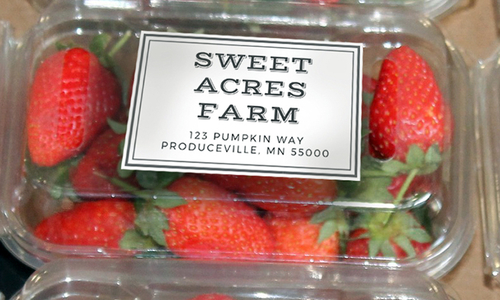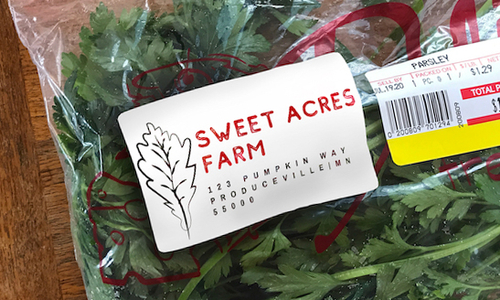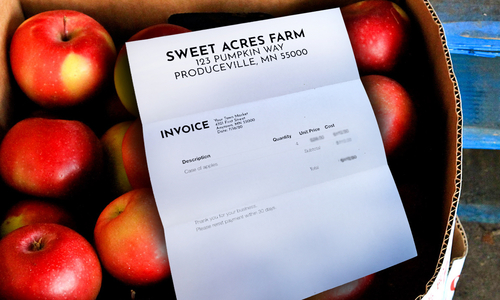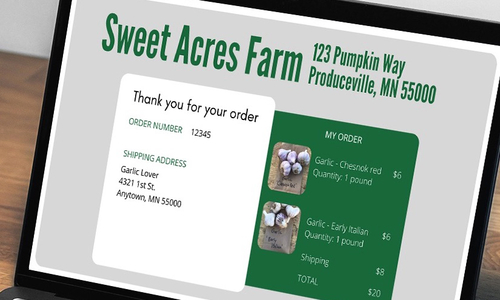Quick facts
Your farm might qualify for an exemption from the major regulations in the Produce Safety Rule based on your annual sales and the types of buyers you sell to.
If your farm is eligible for a qualified exemption:
- You will not be subject to routine FSMA inspections.
- You need to follow rules regarding labeling and signage.
- You need to keep sales records to prove you qualify for the exemption.
What does it mean to be Qualified Exempt?
Under the Produce Safety Rule, your farm might be "Qualified Exempt." This means that a farm qualifies for an exemption from the major regulations in the rule. The exemptions are based on your annual sales and the types of buyers you sell to.
If your farm is eligible for a qualified exemption:
- You will not be subject to routine FSMA inspections.
- You need to follow rules regarding labeling and signage.
- You need to keep sales records to prove you qualify for the exemption.
Labeling and signage requirements
Qualified Exempt farms must follow labeling and signage requirements when selling produce that is considered "covered" by the Produce Safety Rule. This provides contact information for the farm in case there is an issue with the produce.
What is covered produce?
The labeling and signage requirements described here only apply to produce that is considered "covered" under the Produce Safety Rule. Covered produce includes all fruits, vegetables, herbs, sprouts and mushrooms that are not on the FDA’s list of items considered rarely consumed raw.
Labeling requirements
When a food packaging label is included on any food that is considered "covered produce," the name and complete business address of the farm where the produce was grown must be displayed prominently on the label.
These three images show the correct labeling for packaged produce items sold by Qualified Exempt farms.
Signage requirements
When you sell covered produce that doesn’t require a label, you must prominently display the name and complete business address of the farm where the produce was grown at the point of purchase. This can be on a sign, poster, placard or on documents delivered with the produce, and can be handwritten or printed. In the case of internet sales, this can be an electronic notice.
These three images show the correct use of signage for Qualified Exempt farms.
What needs to be included in the complete business address of my farm?
In all cases, the address must be that of the farm where the produce was grown. The address must include:
- Street address or post office box, city, state, and zip code, OR
- Comparable full address if the farm is outside of the U.S.
Minnesota Grown labeling and signage cost share
If you are developing a new label, tag, bag, box, or permanent sign and would like to add the Minnesota Grown logo, you may be eligible to receive up to $250 reimbursement in the current fiscal year (July 1 - June 30). Visit Minnesota Grown to learn more about this cost share program.
Documentation requirements for Qualified Exempt farms
In addition to labeling and signage requirements, you must keep some records to demonstrate that your farm meets the criteria for a qualified exemption. You can find details about standard practices for all record keeping in Subpart O of the Produce Safety Rule.
Required documents
- Sales records to show your rolling 3-year annual average food sales are below $500,000* and the majority of your sales are to qualified end users⁺. Sales receipts must be dated, but do not require a signature or initials.
- Written record that you performed an annual review and verification of your farm’s continued eligibility for the qualified exemption.
*This number is the original 2011 value. It is adjusted each year for inflation. For the most current number, please visit the Minnesota Department of Agriculture Produce Safety Program.
⁺A qualified end-user is either the consumer of the food, regardless of location, or a restaurant or retail food establishment that is located in your state or on your Indian reservation, or not more than 275 miles away from your farm.
How do I keep annual records to show I meet the criteria for a qualified exemption?
We recommend that you make and keep a sales report for each calendar year to track your eligibility for the qualified exemption.
- Fill out the record on at least an annual basis.
- Keep any supporting documentation (receipts, etc.) to help verify your eligibility for a qualified exemption.
- Keep these records for the previous 3 years to demonstrate the 3-year rolling annual average required for eligibility.
The Produce Safety Alliance has templates you can download for record-keeping.
How do I keep records for sales at farmers’ markets or similar transactions to consumers?
In situations where sales are directly to consumers, you could keep track of daily sales totals instead of tracking each individual sale. If you have Internet sales, you could run reports of your total weekly sales online. You must date each sales record.
As a farm that qualifies for an exemption from the Produce Safety Rule, it’s a good idea to get familiar with the written regulations. The Electronic Code of Federal Regulations breaks it down into the different subparts (like subpart O mentioned above) so it’s easy to find what you’re looking for.
- Minnesota Department of Agriculture Produce Safety Program
- Produce Safety Alliance has a wealth of information and resources on the FSMA Produce Safety Rule.
- Visit the U.S. Food and Drug Administration for the full text of the FSMA Final Rule on Produce Safety.
Funding for this publication was provided in part by the Minnesota Department of Agriculture’s Specialty Crop Block Grant Program; by a grant from the U.S. Department of Agriculture (USDA) National Institute of Food and Agriculture Food Safety Outreach Program; and by the Food and Drug Administration through grant PAR-16-137. Its contents are solely the responsibility of the authors and do not necessarily represent the official views of FDA or USDA.
Reviewed in 2020







